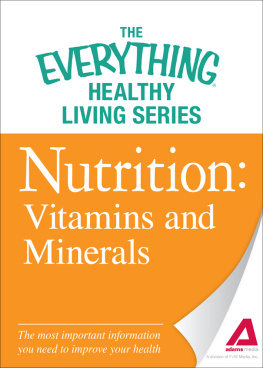Preface
Writing a book of this nature involves more than putting ones understanding on the page. For me, it involved going over again those points I thought I understood and paying special attention those in which my understanding was incomplete or to which pertinent new information had emerged. It involved searching for concordance among related findings and consensus among experts. It involved weighing the strength of evidence and considering the limitations of systematic reviews, meta-analyses and individual original reports. It involved finding clear ways to present complex information without over-striding its truth.
The vitamins occupy a central role in the field of Nutrition. Their discoveries, as factors that prevent specific diseases, marked the emergence of the field. Today, they are also important for their roles in the support of health in ways that often lack the specificity that facilitated their discoveries.
Understanding these latter roles has grown as a result of methodological trends. Improved instrumental analytical sensitivity has facilitated metabolic modeling. Application of molecular technologies has revealed polymorphisms in vitamin transporters, receptors, and enzymes that will, ultimately, allow quantitative needs for vitamins to be indexed to individual metabolic characteristics. Randomized clinical trials have produced databases from which conclusions of increased confidence can be drawn, including application of meta-analytical techniques to identify central findings.
In writing the fourth edition of The Vitamins, I was mindful of comments and suggestions from users of the third edition. Accordingly, I decided to maintain emphases on the roles of vitamins in human health, and to increase documentation to the key scientific literature through expanded sets of footnotes. I am most grateful for the professional assistance that I received from editors Ms Sue Armitage, Ms Caroline Johnson, Ms Carrie Bolger, and Ms Nancy Maragioglio of Academic Press.
I enjoyed writing this fourth edition of The Vitamins. I hope you will find it useful.
G.F. Combs, Jr
Grand Forks, North Dakota
July 2011
Preface to the Third Edition
I have received several valuable criticisms concerning previous editions of The Vitamins. A couple have suggested that the text should cite more of the primary scientific literature. One suggested the inclusion of specific analytical methods. While I considered these suggestions in preparing this edition, I admit to not having responded to either to the degree that I suspect may have been intended.
In my 30 years of teaching in the academy, I became convinced that few students, if any, look to a text book, particularly one on a fairly broad topic, as a portal to the core scientific literature. Neither do I, as a scientist, expect such of the reference texts on my shelf. To get into the literature, I turn first to recent reviews, and then to PubMed and other search engines. So, with this in mind, I decided to maintain The Vitamins as a reference text, citing the key literature mostly as footnotes to the general conclusions they support.
As for methods, I resisted the temptation to include specific procedures. Because analytical methods, in most cases, evolve and improve with technology, I elected to address only the underlying characteristics of vitamins that can be exploited by technologies. I did, however, include a sampling of analytical protocols (), which I expect will soon become out of date.
I did, however, make other changes that I believe enhance the usefulness of the book, particularly as a reference text. Most reflect new understanding in the field. For example, many extra-vitamin A roles of carotenoids are emerging, and genomics approaches are leading to new ways of understanding differences between individuals in vitamin needs and functions. The distribution of allelic variants of vitamin-dependent enzymes may explain anomalies previously considered simply as part of biologic variability. This approach is likely to lead to individualized food and nutrition guidance.
G.F. Combs, Jr
Grand Forks, North Dakota
September, 2005
Preface to the Second Edition
Since writing the first edition of The Vitamins, I have had a chance to reflect on that work and on the comments I have received from Cornell students and from various other instructors and health professionals who have used it at other institutions. This, of course, has been an appropriately humbling experience that has focused my thinking on ways to improve the book. In writing the second edition I have tried to make those improvements, but I have not changed the general format, which I have found to facilitate using the book as a classroom text.
Those familiar with the first edition will find the revision to be expanded and more detailed in presentation in several ways. The most important changes involve updating to include new information that has emerged recently; particularly, important findings in the areas of molecular biology and clinical medicine. This has included the addition of key research results, many in tabular form, and the expansion of the footnote system to include citations to important research papers. The reference lists following each chapter have been expanded, but these citations include mainly key research reviews, as in the first edition. While each chapter has been expanded in these ways, the most significant changes were made in the chapters on vitamin A (): each has been given an internal table of contents; an overview of the general significance of the vitamin in nutrition and health has been included; the topics of deficiency and toxicity are discussed under separate headings.










